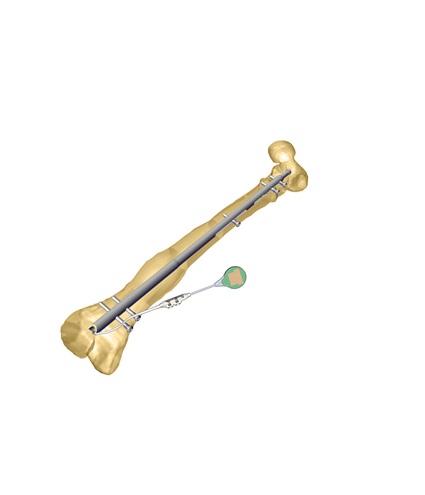Fitbone™ Transport and Lengthening System
THIS INFORMATION IS FOR HEALTHCARE PROFESSIONALS ONLY
THIS INFORMATION IS FOR HEALTHCARE PROFESSIONALS ONLY

Bone Transport and lengthening, retrograde application.
| Q.ty | Catalogue N. | Description |
|---|---|---|
| 1 | 99-6000XXXX
|
FITBONE TRANSPORT NAIL (TN) / TRANSPORT AND LENGTHENING NAIL (TLN) |
| 6 | 60000XXX
|
FITBONE LOCKING SCREW D4.5 LXX (SHORT (L20-50) AND LONG THREADED( L20-80)) |
| 1 | 60001644
|
FITBONE CONTROL SET US PLUG 120V |
| 1 | 6990863
|
FITBONE GENERAL TRAY |
| 1 | 6990864
|
FITBONE REAMER TRAY TAA L480 |
| 1 | 6990865
|
FITBONE INSTRUMENTS TRAY |
| 1 | 6991040
|
FITBONE TUBE SYSTEM TAA |
| 1 | 6992059
|
FITBONE INSTRUMENT TRAY TAA13 (ONLY FOR 13MM NAILS) |
| 1 | 60001780
|
FITBONE SUBCUTANEOUS ENERGY RECEIVER |


Large proximal or distal defect, with or without loss of length. (a) Large distal defect in the fem...
Read MoreLarge central bony defect. (a) LRS ADVanced (53000 series) in place. (b) Proximal and distal metap...
Read MoreLarge peripheral bony defect. (a) LRS ADVanced (53000 series) in place. (b) Two osteotomies perfor...
Read More(a) Small distal defect in the femur. LRS ADVanced (53000 series) in place. (b) Immediate compressi...
Read MoreFitbone™ Transport and Lengthening System
Bone Transport and lengthening, antegrade application....
Read MoreFoot and Ankle Charcot Reconstruction with External Fixation
Surgical reconstruction of foot and ankle Charcot with external fixation is especially useful in the presence of poor bone quality,Read MoreExpert Tips on How to Medically Diagnose Charcot Arthropathy
The diagnosis of Charcot neuroarthropathy of the foot and ankle can be challenging due to a lack of information inRead MoreThis website is reserved only for Healthcare Professionals and their staff. Therefore, the access to these information is denied to non professional audience.